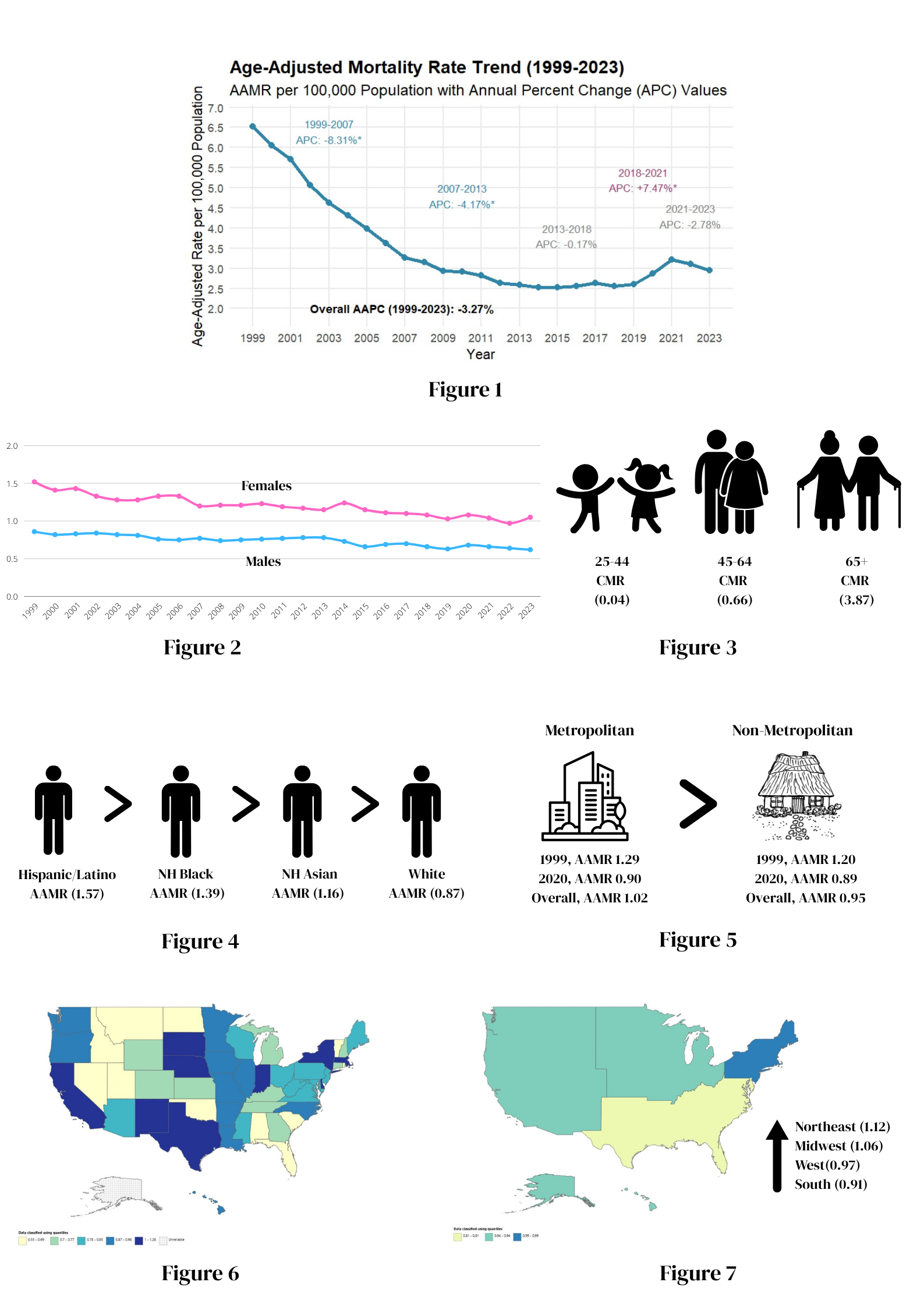Sunday Poster Session
Category: Biliary/Pancreas
P0094 - Mortality Trends and Disparities in Gallblader Cancer in the United States,1999-2023: An Analysis of CDC WONDER Database
Sunday, October 26, 2025
3:30 PM - 7:00 PM PDT
Location: Exhibit Hall

Sana Altaf, MBBS (she/her/hers)
Deccan College of Medical Sciences
Irving, TX
Presenting Author(s)
Maha Sajjad, MBBS1, Sana Altaf, MBBS2, Sajjad U.. Hasan, MBBS, MPH3, Muhammad Imaz Bhatti, MBBS1, Maryam Saghir, MBBS4, Sahil Jairamani, MBBS5, Zahin Shahriar, MBBS6
1King Edward Medical University, Lahore, Lahore, Punjab, Pakistan; 2Deccan College of Medical Sciences, Irving, TX; 3Amna Inayat Medical College, Sheikhupura, Pakistan, Lahore, Punjab, Pakistan; 4Jinnah Sindh Medical University, Karachi, Sindh, Pakistan; 5Liaquat University of Medical and Health Science, Jamshoro, Pakistan, Jamshoro, Sindh, Pakistan; 6Dhaka Medical College and Hospital, Dhaka, Dhaka, Bangladesh
Introduction: Gallbladder cancer is a rare yet aggressive malignancy, accounting for approximately 1.2% of all gastrointestinal cancers in the United States. In this study, we aim to analyze the regional and demographic trends in gallbladder cancer-related mortality among U.S. adults aged ≥25 years from 1999 to 2023.
Methods: Mortality data for gallbladder cancer were sourced from the CDC WONDER Multiple Cause of Death database using the ICD-10 code C23. We calculated both crude mortality rates (CMRs) and age-adjusted mortality rates (AAMRs) per 100,000 individuals. Joinpoint regression was used to model temporal trends, estimating the annual percent change (APC) and average annual percent change (AAPC), with 95% confidence intervals (CIs).
Results: Between 1999 and 2023, 55,383 gallbladder cancer-related deaths occurred in the United States. AAMR significantly declined from 1.28 in 1999 to 0.85 in 2023 (AAPC: -1.41%; 95% CI: -1.59 to -1.23). Mortality disparities were striking across various subgroups. Females experienced a higher AAMR than males (1.20 vs. 0.74). Racial and ethnic minorities faced elevated rates, with Hispanics at the highest risk (AAMR: 1.57), followed by non-Hispanic (NH) Black (1.39), NH Asian/Pacific Islander (1.16), and NH White (0.87) populations. Regionally, the Northeast reported the highest AAMR (1.12), exceeding the Midwest (1.06), West (0.97), and South (0.91). The state-level burdens were most severe in New York, New Mexico, the District of Columbia, Illinois, and Delaware. Metropolitan areas had higher rates than non-metropolitan areas (AAMR: 1.02 vs. 0.95). Adults aged 65 years and older had the highest CMR (3.87).
Discussion: Despite a significant national decline in gallbladder cancer mortality over 25 years, ongoing disparities across sex, race/ethnicity, age, and geography highlight inequitable burdens. Targeted interventions are crucial to improve early detection, treatment access, and supportive care for disproportionately affected populations.

Figure: Figure 1: Overall age-adjusted mortality rates per 100,000 persons
Figure 2: Sex-stratified trends (age-adjusted mortality rates per 100,000 persons)
Figure 3: Age groups (crude mortality rates per 100,000 persons)
Figure 4: Racial disparities (age-adjusted mortality rates per 100,000 persons)
Figure 5: Urbanization trends (age-adjusted mortality rates per 100,000 persons)
Figure 6: State-stratified trends (age-adjusted mortality rates per 100,000 persons)
Figure 7: Census region-stratified trends (age-adjusted mortality rates per 100,000 persons)
Disclosures:
Maha Sajjad indicated no relevant financial relationships.
Sana Altaf indicated no relevant financial relationships.
Sajjad Hasan indicated no relevant financial relationships.
Muhammad Imaz Bhatti indicated no relevant financial relationships.
Maryam Saghir indicated no relevant financial relationships.
Sahil Jairamani indicated no relevant financial relationships.
Zahin Shahriar indicated no relevant financial relationships.
Maha Sajjad, MBBS1, Sana Altaf, MBBS2, Sajjad U.. Hasan, MBBS, MPH3, Muhammad Imaz Bhatti, MBBS1, Maryam Saghir, MBBS4, Sahil Jairamani, MBBS5, Zahin Shahriar, MBBS6. P0094 - Mortality Trends and Disparities in Gallblader Cancer in the United States,1999-2023: An Analysis of CDC WONDER Database, ACG 2025 Annual Scientific Meeting Abstracts. Phoenix, AZ: American College of Gastroenterology.
1King Edward Medical University, Lahore, Lahore, Punjab, Pakistan; 2Deccan College of Medical Sciences, Irving, TX; 3Amna Inayat Medical College, Sheikhupura, Pakistan, Lahore, Punjab, Pakistan; 4Jinnah Sindh Medical University, Karachi, Sindh, Pakistan; 5Liaquat University of Medical and Health Science, Jamshoro, Pakistan, Jamshoro, Sindh, Pakistan; 6Dhaka Medical College and Hospital, Dhaka, Dhaka, Bangladesh
Introduction: Gallbladder cancer is a rare yet aggressive malignancy, accounting for approximately 1.2% of all gastrointestinal cancers in the United States. In this study, we aim to analyze the regional and demographic trends in gallbladder cancer-related mortality among U.S. adults aged ≥25 years from 1999 to 2023.
Methods: Mortality data for gallbladder cancer were sourced from the CDC WONDER Multiple Cause of Death database using the ICD-10 code C23. We calculated both crude mortality rates (CMRs) and age-adjusted mortality rates (AAMRs) per 100,000 individuals. Joinpoint regression was used to model temporal trends, estimating the annual percent change (APC) and average annual percent change (AAPC), with 95% confidence intervals (CIs).
Results: Between 1999 and 2023, 55,383 gallbladder cancer-related deaths occurred in the United States. AAMR significantly declined from 1.28 in 1999 to 0.85 in 2023 (AAPC: -1.41%; 95% CI: -1.59 to -1.23). Mortality disparities were striking across various subgroups. Females experienced a higher AAMR than males (1.20 vs. 0.74). Racial and ethnic minorities faced elevated rates, with Hispanics at the highest risk (AAMR: 1.57), followed by non-Hispanic (NH) Black (1.39), NH Asian/Pacific Islander (1.16), and NH White (0.87) populations. Regionally, the Northeast reported the highest AAMR (1.12), exceeding the Midwest (1.06), West (0.97), and South (0.91). The state-level burdens were most severe in New York, New Mexico, the District of Columbia, Illinois, and Delaware. Metropolitan areas had higher rates than non-metropolitan areas (AAMR: 1.02 vs. 0.95). Adults aged 65 years and older had the highest CMR (3.87).
Discussion: Despite a significant national decline in gallbladder cancer mortality over 25 years, ongoing disparities across sex, race/ethnicity, age, and geography highlight inequitable burdens. Targeted interventions are crucial to improve early detection, treatment access, and supportive care for disproportionately affected populations.

Figure: Figure 1: Overall age-adjusted mortality rates per 100,000 persons
Figure 2: Sex-stratified trends (age-adjusted mortality rates per 100,000 persons)
Figure 3: Age groups (crude mortality rates per 100,000 persons)
Figure 4: Racial disparities (age-adjusted mortality rates per 100,000 persons)
Figure 5: Urbanization trends (age-adjusted mortality rates per 100,000 persons)
Figure 6: State-stratified trends (age-adjusted mortality rates per 100,000 persons)
Figure 7: Census region-stratified trends (age-adjusted mortality rates per 100,000 persons)
Disclosures:
Maha Sajjad indicated no relevant financial relationships.
Sana Altaf indicated no relevant financial relationships.
Sajjad Hasan indicated no relevant financial relationships.
Muhammad Imaz Bhatti indicated no relevant financial relationships.
Maryam Saghir indicated no relevant financial relationships.
Sahil Jairamani indicated no relevant financial relationships.
Zahin Shahriar indicated no relevant financial relationships.
Maha Sajjad, MBBS1, Sana Altaf, MBBS2, Sajjad U.. Hasan, MBBS, MPH3, Muhammad Imaz Bhatti, MBBS1, Maryam Saghir, MBBS4, Sahil Jairamani, MBBS5, Zahin Shahriar, MBBS6. P0094 - Mortality Trends and Disparities in Gallblader Cancer in the United States,1999-2023: An Analysis of CDC WONDER Database, ACG 2025 Annual Scientific Meeting Abstracts. Phoenix, AZ: American College of Gastroenterology.
